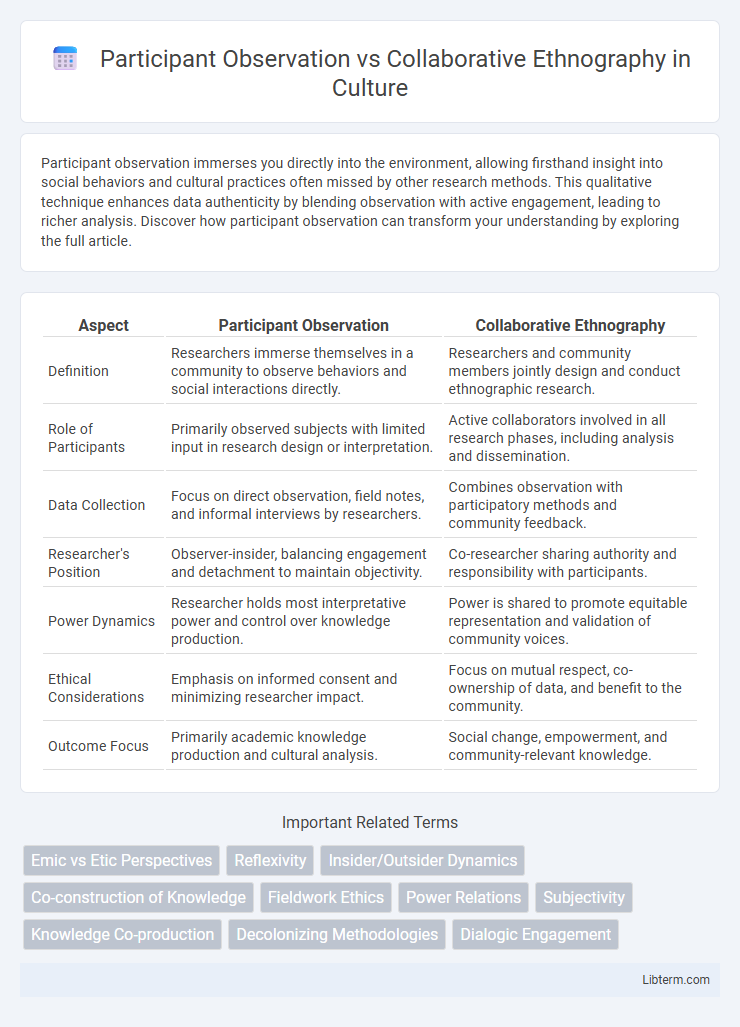Participant observation immerses you directly into the environment, allowing firsthand insight into social behaviors and cultural practices often missed by other research methods. This qualitative technique enhances data authenticity by blending observation with active engagement, leading to richer analysis. Discover how participant observation can transform your understanding by exploring the full article.
Table of Comparison
| Aspect | Participant Observation | Collaborative Ethnography |
|---|---|---|
| Definition | Researchers immerse themselves in a community to observe behaviors and social interactions directly. | Researchers and community members jointly design and conduct ethnographic research. |
| Role of Participants | Primarily observed subjects with limited input in research design or interpretation. | Active collaborators involved in all research phases, including analysis and dissemination. |
| Data Collection | Focus on direct observation, field notes, and informal interviews by researchers. | Combines observation with participatory methods and community feedback. |
| Researcher's Position | Observer-insider, balancing engagement and detachment to maintain objectivity. | Co-researcher sharing authority and responsibility with participants. |
| Power Dynamics | Researcher holds most interpretative power and control over knowledge production. | Power is shared to promote equitable representation and validation of community voices. |
| Ethical Considerations | Emphasis on informed consent and minimizing researcher impact. | Focus on mutual respect, co-ownership of data, and benefit to the community. |
| Outcome Focus | Primarily academic knowledge production and cultural analysis. | Social change, empowerment, and community-relevant knowledge. |
Introduction to Participant Observation and Collaborative Ethnography
Participant observation involves researchers immersing themselves in a community to observe behaviors and social interactions firsthand, providing in-depth qualitative data through direct engagement. Collaborative ethnography emphasizes active partnership between researchers and participants, co-creating knowledge and ensuring that community members have a voice in the interpretation of findings. Both methods prioritize understanding cultural contexts but differ in levels of researcher involvement and community collaboration.
Defining Participant Observation
Participant observation is a qualitative research method where the researcher immerses themselves in a community or social setting to observe behaviors and interactions firsthand, often participating in daily activities to gain insider perspectives. This method emphasizes prolonged engagement and direct experience, allowing for nuanced understanding of cultural practices and social dynamics. Unlike collaborative ethnography, participant observation typically involves a more individual-focused approach without necessarily involving community members in the research design or analysis.
Key Features of Collaborative Ethnography
Collaborative ethnography emphasizes active participation and shared authority between researchers and community members, ensuring multiple voices shape the research process and outcomes. It prioritizes co-creation of knowledge, mutual respect, and ethical accountability, fostering trust and empowerment within the studied group. Unlike traditional participant observation, this approach integrates collective reflection and dialogue, making the research more inclusive and socially responsible.
Historical Development of Both Methods
Participant observation emerged in the early 20th century within anthropological fieldwork, pioneered by scholars like Bronislaw Malinowski who emphasized immersive study of cultures through direct involvement. Collaborative ethnography gained prominence in the late 20th century as a response to concerns about researcher authority and representation, advocating for participatory approaches where community members co-create knowledge. Both methods evolved to deepen cultural understanding, with participant observation rooted in individual researcher immersion and collaborative ethnography emphasizing shared authority and reflexivity.
Methodological Differences
Participant Observation involves researchers immersing themselves in a community to observe behaviors and interactions from an insider perspective, often maintaining a degree of researcher objectivity. Collaborative Ethnography emphasizes co-creation of knowledge where community members actively participate in data collection, analysis, and interpretation, fostering shared authority and reflexivity. Methodological differences center on the role of stakeholders, with Participant Observation prioritizing researcher-led inquiry and Collaborative Ethnography promoting partnership and empowerment in the research process.
Researcher-Participant Relationships
Participant observation involves the researcher immersing themselves in the community to observe behaviors and interactions firsthand, maintaining a degree of detachment to analyze social dynamics objectively. Collaborative ethnography emphasizes a co-constructed research process where participants actively engage in shaping the study, fostering egalitarian relationships and shared authority over data interpretation. These differing approaches influence the depth of trust, power distribution, and ethical considerations within researcher-participant relationships, impacting the authenticity and relevance of ethnographic findings.
Ethical Considerations in Each Approach
Participant observation demands careful attention to informed consent and the researcher's impact on the community, emphasizing privacy and minimizing deception during data collection. Collaborative ethnography prioritizes mutual respect and shared decision-making, ensuring transparency and equity by involving participants actively in analyzing and disseminating findings. Both approaches require ongoing ethical reflexivity to balance power dynamics and protect the rights and well-being of individuals within research settings.
Data Collection and Analysis Strategies
Participant observation emphasizes immersive data collection through direct engagement and prolonged interaction within the community, allowing researchers to capture nuanced social behaviors and contexts. Collaborative ethnography involves co-creating data with participants, using shared analysis sessions to validate findings and incorporate multiple perspectives, thereby enhancing data reliability and reflexivity. Both methods employ qualitative analysis techniques, but collaborative ethnography prioritizes iterative feedback loops with participants to refine interpretations and ensure ethical accountability.
Advantages and Limitations Compared
Participant observation offers deep immersion in the community, enabling researchers to capture nuanced behaviors and social dynamics through direct experience; however, it risks observer bias and can be time-consuming. Collaborative ethnography prioritizes co-creation of knowledge by involving community members as active partners, which enhances ethical considerations and enriches data with insider perspectives, but it may face challenges in balancing power dynamics and extending timelines. Both methods provide valuable qualitative insights, yet participant observation emphasizes researcher-driven interpretation, while collaborative ethnography focuses on shared authority and inclusivity.
Choosing Between Participant Observation and Collaborative Ethnography
Choosing between participant observation and collaborative ethnography depends on the research objectives and level of community involvement desired. Participant observation emphasizes immersive engagement with minimal interference, ideal for capturing natural behaviors and individual perspectives. Collaborative ethnography fosters active partnership with participants in data collection and analysis, enhancing reflexivity and empowering community voices.
Participant Observation Infographic

 libterm.com
libterm.com